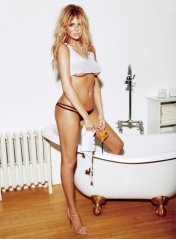If before I wasn’t thin enough, I’m now condemned for not being ‘normal’, and ‘normal’ today is a bodacious figure, with high sex appeal, oozing femininity. Apparently.
Every news article, blog and body issue special of our favourite magazine blames an unhealthy distortion and mold of ‘beauty’ depicted in the very newspapers and glossy fashion mags’ we consume daily. Not to mention the movies, television shows and music clip videos that ‘feature’ underweight women or an unrealistic portrayal of what is beautiful and normal. We see these stories, these articles that attack models for being skinny and victimise the women who fall pray to the pressure. Unfortunately most of these stories are featured opposite an advertisement or editorial containing exactly what they oppose and are rendered irrelevant anyway.
Feministic media, so opposed to an ‘ideal’ beauty, has created a whole new one. Most ironically, it contradicts everything these body-image-conscience women hated to begin with.
As a result of the backlash, we have created a war on thin, ‘Skinny vs. Curvy’ and it’s not reserved to those featured on runways or covers. It’s anyone. A thin girl on the street, the dieter in the office, a size 6 and size 12 in a change room. Plus size modelling is the answer according to these corporals of ‘realistic’ beauty. But through the language and images used, they are really just replacing one ideal with another.

And what’s to happen to the girls who are naturally thin, or lead a healthy lifestyle? Well they are now segregated for being unhealthy and outside the new sexy, curvaceous ‘norm’. Robyn Lawley, the Miranda Kerr equivalent in the plus-size market, was featured on the front cover of The Australian Magazine quoting,
“I’m normal size, I wish we could all be known as models, rather than plus size. It’s the skinny models who should be called minus size”.
While the first part of that remark makes sense, models shouldn’t be segregated according to their division, she complete
Let it be known, I am in no way underestimating the seriousness of health issues influenced by the media’s portrayal of ‘beauty’ and ideal weight. I am rather highlighting the notion that amongst the strife and fight against ‘anorexic’ models, a new bread of overtly sexy, curvaceous hourglass shapes now haunts the magazine pages as the new body-to-be and aura to personify.ly undermines her comment by stating skinny models should be labelled as “minus-size”. There it goes. ‘Us vs. them’, ‘skinny vs. normal’. This isn’t a social revolution, this is a war.
As misogynistic as it is, it’s all about ‘tits and ass’. Sex appeal, bodacious curves, flirty smirks, little to no clothes and throw in a raised brow for good measure. If your overweight, apparently you’re supposed to be super sexual about it. Too bad if you don’t have a lovely booty, a little junk in the trunk, or some bosom on top and a cinched waist in between all that, because that’s what ‘plus-size’ models are representing. Apparently this is what’s normal? Further embedding sexual ideals, these images of supposedly ‘bigger’ women are accompanied with words like ‘over-heated’, ‘hot’, ‘voluptuous’, and ‘sexy’.
 Well-known plus-size model, Kate Upton, was featured in GQ Magazine recently promoting such. The slide show of photos online accompanies statements like “blonde bombshell” and “voluptuous curves” with suggestive words like “burst” and notes her “several memorable provocative videos”. Upton’s’ pictures borderline soft porn, which I suppose could be excused for the target audience of a men’s magazine. Or should it?
Well-known plus-size model, Kate Upton, was featured in GQ Magazine recently promoting such. The slide show of photos online accompanies statements like “blonde bombshell” and “voluptuous curves” with suggestive words like “burst” and notes her “several memorable provocative videos”. Upton’s’ pictures borderline soft porn, which I suppose could be excused for the target audience of a men’s magazine. Or should it?
Perhaps such a figure, which doesn’t fit designers’ samples of size 6, is so alien that the only way to show it off is to strip it naked or skimp it out? Our ‘skinny’ ideals are being replaced by curves and increased sexuality. This is not displaying an acceptance of diversity, but a clear exchange of one version of ‘perfect’ with another. And other than Kate’s ‘chest puppies’, does she even look close to ‘plus’ to you?

Despite her smaller frame, Kate Upton doesn’t escape the skinny vs. curvy scrutiny. Pro-thin blog, Skinny Gossip, describe her as a “squishy brick” followed by, “Is this what American women are “striving” for now? The lazy, lardy look? Have we really gotten so fat in this country that Kate is the best we can aim for? Sorry, but: eww!”
A plus-size model can vary anywhere up to an Australian size 16 or 18; however, the most successful models tend to maintain a size 10 average. Crystal Renn, a ‘plus-size’ model from the U.S, appeared on the Today morning show in Ame
rica after she was photo-shopped to look thinner, much to her anger. Leslie Goldman, co-host of the program, wrote about their interview afterwards, addressing the fact that Crystal Renn is no way ‘plus-size’.
“The main physical characteristic that jumps out and whomps you upside the head the first time you lay eyes on Crystal Renn in person: She is not big. Not in any way, shape or form. If you and your BFF, on your cattiest of catty days, were drunk, PMS-ing and had just swallowed a bottle of mean girl pills, and Renn walked by, you still wouldn’t think to comment on her weight. If you ever saw her shopping in the plus-size department of a clothing store, you’d think she was picking up a gift for a friend.”
One of the most interesting points in Goldman’s post, was how at a size 10 herself – a size she had previously thought was thin – she felt more insecure after comparing herself to Renn, knowing that at her size she would also be considered ‘plus’. It’s intriguing that comparison, regardless of shape, can still result in insecurity.
The main argument against ‘anorexic’ models is that they don’t represent the majority of women. Plus Model Magazine reported,
“Twenty years ago the average fashion model weighed 8% less than the average woman. Today she weighs 23% less.”
This was construed to mean models are getting thinner, when in reality people are getting bigger! The Australian Bureau of Statistics reports that over half the adult population is overweight or obese, which has increased from 44 per cent in 1995. Personal trainer, Michelle Bridges, from The Biggest Loser wrote in an article regarding the ‘Danish fat tax’, that the promotion of a healthy population is “not about plus-size models, body image or eating disorders. It’s about quality and quantity of life.” She continues, “The more we get bogged down in the social acceptance of obesity the more difficult it is to make change – profound change – to our health and quality of life”. Amongst the praise for body shape variety within our media, we should not let vital notions of health and well being go astray.
We are told that this is the plus-size revolution, what average-weight women have been longing for, and yet seats to plus-size fashion shows remain empty. Last year’s Sydney Fashion Festival sold only 64 tickets out of 500 to its Big is Beautiful show, despite other shows during the event selling out. It is an increase however on 2009, when only 13 tickets sold to the same Big is Beautiful event. Editor of Harpers Bazaar, Edwina McCann, understood the low sales and responded, “I d
on’t think the consumer is as obsessed with [plus-size] as the media is. I think the consumer is quite happy to accept the fact that a model, like an Olympic swimmer, is usually an exceptional beauty and doesn’t look like the rest of us.”

So, does it all just come down to selling a magazine, clothing and every other purchasable item involved? Surely not.
There has not been a change in body image, but rather a change in what is perceived as the ‘ideal’, which still alienates and excludes the majority of women everywhere. Instead of viewing beauty as all inclusive, we are still looking to find the ‘perfect’ version of us who we can look to and admire, and when we still cannot achieve their level of ‘perfection’, we attack and condemn it for being unreachable. Plus size models are just bigger girls photo-shopped of dimples, vains, uneven skin-tone and wrinkles. What’s different? Nothing.



